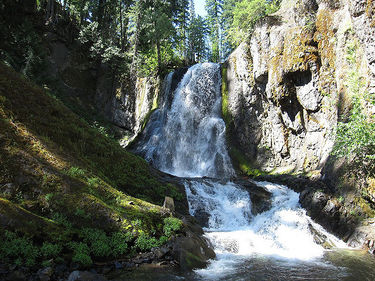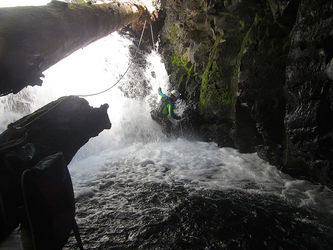Little Goose Creek
| Rating: | |||||||||||||||||||||||||||||||
|---|---|---|---|---|---|---|---|---|---|---|---|---|---|---|---|---|---|---|---|---|---|---|---|---|---|---|---|---|---|---|---|
| | Raps:3-5, max ↨65ft
Red Tape:No permit required Shuttle:None Vehicle:Passenger | ||||||||||||||||||||||||||||||
| Location: | |||||||||||||||||||||||||||||||
| Condition Reports: | 3 Aug 2023
"Great run! Definitely could be rated much higher with the scenery in this canyon. Lush greens, bright red rocks, interesting rock formations, 1 beauti |
||||||||||||||||||||||||||||||
| Best season: | Aug-Sept
|
||||||||||||||||||||||||||||||
| Regions: | |||||||||||||||||||||||||||||||
Introduction[edit]
Little Goose Creek is a fun canyon in Gifford Pinchot National Forest. Although it is not very technically difficult, the canyon is quite scenic. There are at least two rappels, although you may end out doing more depending on water level and your comfort. There are many cascades that can be downclimbed, wading, and a few short swims. Full wetsuit required. Creek seems to sport reasonably high water into August. The creek was still cold in mid-late August 2017, suggesting it may be spring-fed.
Expect to encounter non-canyoneer hikers at the upper falls on summer weekends. There is an unofficial trail that follows along the south rim of the canyon providing access to the bottom of R1 and R2. Adventurous hikers may sometimes descend to the top of the narrows.
- For a longer full day adventure, combine with Mosquito Creek just up the road.
Approach[edit]
Parking options:
- There is a small pullout on the east side of FR 88 just south of the bridge over Little Goose Creek. This pullout can accommodate one car.
- About 300ft south of the bridge on the west side of FR88 is a small spur road / dispersed camping site with plenty of room for a few vehicles.
- A few hundred yards further is a spur road branching off to the southwest with plenty of room on the shoulder for parking.
From the pullout above, follow a user trail into the forest along the south side of the creek. Go a few hundred feet and locate a steep dirty scramble trail (scramble down or rappel) that drops immediately into the drainage below the bridge. R1 is a few minutes walk downstream.
Descent[edit]
- R1 - 15ft.
- R2 Little Goose Falls - 60ft. Large plunge-pool at the base may contain hydraulics in high flow. Anchor off a boulder mid-creek, or use a tree DCR to rappel out of the flow and evade the pool. Beware rockfall hazard on the dry rap.
Expect a long stream walk with much tedious rock-hopping below R2. There are some interesting columnar basalt formations on the north side of the canyon. Keep heading downstream through a number of short downclimbs.
- First significant obstacle below R2 is a 30ft low-angle ramp. Downclimb carefully or rappel. Rappelling might be safer if wet & slippery.
- 20ft two tier ramp with a hanging pool between. Pool is deep (swimmer) and may have a hydraulic in high flow. There is a cave-like space DCL of the pool. Slide down the first tier DCR and downclimb the second tier DCR. There is another short swimmer at the bottom. A tributary enters DCR at the bottom.
After what seems like much walking, the nature of the creek suddenly changes as it drops into a tight narrows. Use caution as the area ahead could be dangerous in high water conditions. Escape would be very difficult within the narrows. There are two obstacles immediately ahead:
- 1) 12ft ramp marks the entrance to the narrows.
- 2) Immediately below the 12ft ramp, the creek turns right and goes over a 35ft drop (R3). There is a short swimmer at the bottom and the creek drops over a final 2ft step at the very bottom. Beware potential hydraulic below the 35ft step.
Low or Moderate Flow: Downclimb the 12ft ramp DCR, cross the watercourse and rappel from a rootball (DCL) wedged atop the 35ft drop.
High Flow: Climb up 20-30ft DCR on a mini-ridge and rappel from a tree (50ft) to bypass both obstacles.
- Ahead, the narrows swings left to the top of a 20ft ramp. Downclimb carefully DCR or rappel from a log. At the bottom is a deep plunge pool (swimmer) which may have some current. Beware a couple of logs wedged out in the middle of the pool as the current may sweep you into them.
Exit the pool and make your way down through a beautiful section of narrows with a few more easy downclimbs to eventually reach the confluence with Trout Lake Creek.
Exit[edit]
On reaching the confluence with Trout Lake Creek, the flow triples. Continue downstream another 100ft or so. There might be an easier way out further downstream(?), but we exited DCR directly up a steep forested slope bearing slightly climber's right on the ascent to detour around a cliff band.
- Just to climber's left on the same set of cliffs is a small cave; perhaps 20ft deep. Bear prints were found in the wet dirt inside the cave in Aug 2017.
Continue your way up generally open forested slopes for several hundred vertical feet. We followed an old trail (elk trail) along the north edge of a clear cut, but instead of following trails all the way back to the bridge as described in the original beta, we pushed on up along the west side of the clear cut and exited to FR88. Easy hike back along the road.
Red tape[edit]
None.
Beta sites[edit]
 CanyoneeringNorthwest.com (archive.org) : Little Goose Creek
CanyoneeringNorthwest.com (archive.org) : Little Goose Creek

